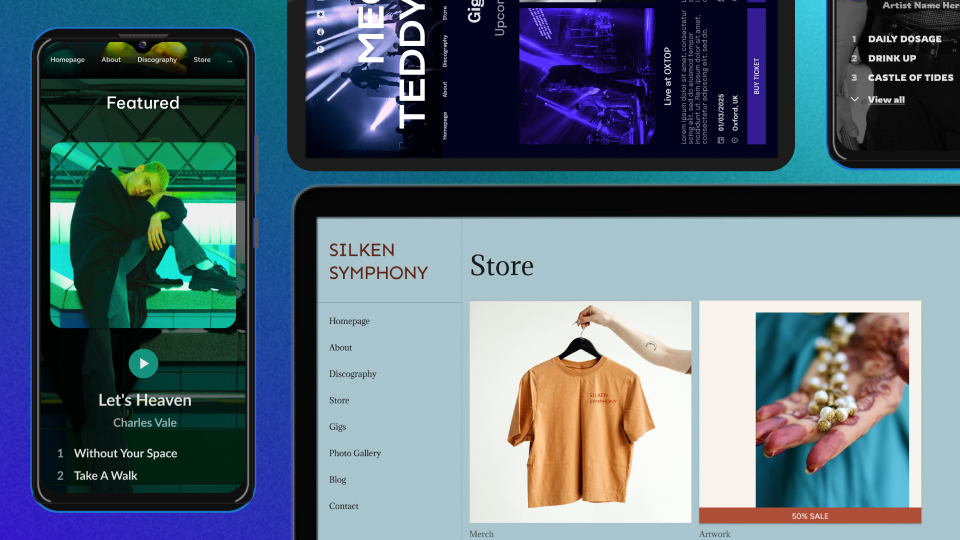Pros and Cons: Noiseyard vs. Traditional Website Builders

Some musicians are turning to Noiseyard as a simpler alternative to traditional website builders, but how does it actually compare? Musicians already juggle a lot – recording, rehearsing, promoting, and playing shows – so when it comes to building a website, spending hours tweaking design settings can feel like a non starter. That’s why the comparison between Noiseyard and the usual site builders matters. Both help you create a home base for your music, but they take very different routes to get you there.
This post walks through the real differences, what helps, what slows you down, and what might just surprise you.
Noiseyard: Music-Ready Without the Extra Steps
Noiseyard isn’t trying to be a blank canvas. It’s more like a layout that already understands what musicians typically need. Instead of building every page from scratch, you’re answering a few simple prompts – what kind of artist you are, where your music lives, what you’re promoting – and the site comes together on its own. You don’t have to choose from a hundred widgets or fiddle with columns and spacing. It sets up asite that highlights your music, bio, tour dates, merch, and mailing list right away, so you can focus on adding content instead of rearranging blocks.
Pros:
• Purpose-built: The layout, sections, and features are designed around music. Your homepage can highlight new releases, tour dates, embedded players, or merch.
• No setup stress: You’re not dragging boxes around. Answer a few questions, get a fully built site.
• No sales commission: Sell music or merch directly and keep 100% of it.
• SEO runs in the background: Title tags, schema markup, and mobile optimization happen behind the scenes.
• Mailing list built-in: Stay connected without needing extra tools or integrations.
• Helpful customer support: Help is responsive and actually geared toward musicians, not generic business users.
Cons:
• Limited layout control: You can change your content, but not every detail of how it’s placed.
• Niche use case: Great for solo artists, bands, DJs, but less suited if you’re building a blog network, online magazine, or general creative agency site.
Traditional Website Builders: Infinite Flexibility, If You Have the Time
Platforms like Wix, Squarespace, and WordPress have been around for years. They offer nearly unlimited flexibility, which can be a huge plus if you know exactly what you want and how to build it. You can craft a completely custom setup, from landing pages to ecommerce to animations, but it also means you’re responsible for making all those decisions. Nothing comes pre-structured for musicians, so you’re doing all the heavy lifting when it comes to layout, content strategy, and design flow.
(Photo by Markus Winkler on Pexels)
Pros:
• Full control over layout and design: You can change or modify anything layout, structure, page elements. If you want your bio floating next to a looping video, you can probably do it.
• App/plugin ecosystems: Add email signup forms, e-commerce, analytics, social feeds – you name it.
• Strong support communities: If you run into trouble, there’s documentation and forums to help.
Cons:
• Takes time to set up: Expect to spend hours (or days) getting it how you want it.
• Not music-aware by default: Want a proper embedded player, gig section, or merch grid? You’ll need to install it or build it yourself.
• Can get pricey: Themes, plugins, and business-level features are often locked behind paid tiers. Here’s a look at Wix’s pricing.
Where They Really Differ: A Quick Breakdown
With Noiseyard, you’re up and running in minutes. You don’t need to plan layouts, adjust spacing, or how to lay out your album page, it’s all there by default. Traditional builders give you more room to create but also ask for more time, more trial and error, and sometimes more cash.
Noiseyard includes native music players, a merch section that doesn’t charge commission, and automatic mailing list tools. Everything is geared toward musicians out of the gate. Traditional builders usually need a few plugins and extra setup to get the same results.
(Photo by Markus Spiske on Pexels)
Customization is another big divide. Noiseyard limits design choices to keep things smooth and clean. Traditional builders, on the other hand, let you tweak every single pixel, but that freedom can get overwhelming fast.
Some artists prefer getting a site live quickly so they can move on to recording or performing. Others enjoy the process of building a unique online space from the ground up. Both are valid and that difference is often what steers someone toward Noiseyard or a traditional builder.
Which One Should You Use?
If you’re a musician who just wants a good-looking, functional site to share your work and grow your fanbase, Noiseyard strips out the fluff and gives you exactly what you need. You can launch in an afternoon, spend zero time on design, and still come off professional.
On the other hand, if you love the idea of crafting a site from scratch or creating something totally outside the box, traditional builders will give you all the space you need.
It’s kind of like recording a song: Noiseyard is like using a template that’s pre-mixed for your genre. Traditional builders hand you the raw files and say, “Go wild.”
Pick the one that fits your workflow, not the one with the longest feature list.
Categorised in: Feature
This post was written by Admin



